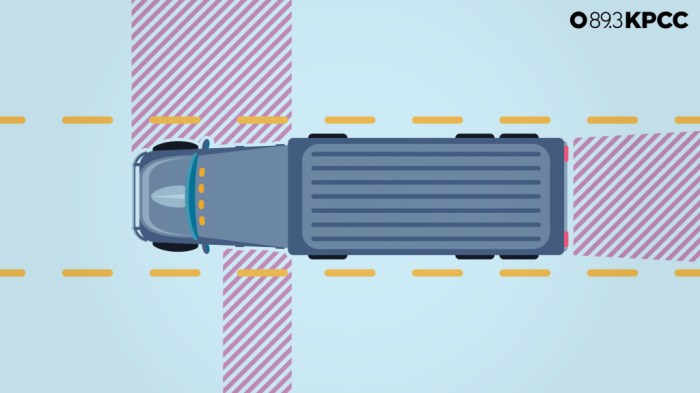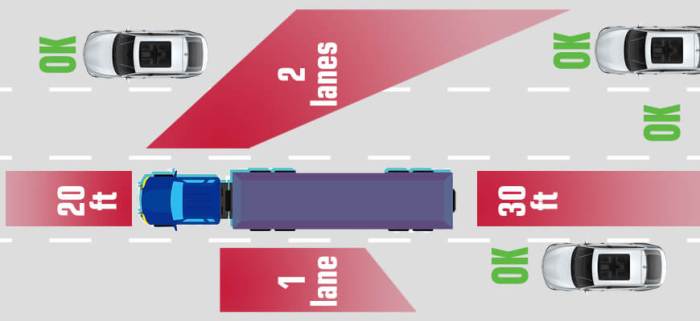Unlike passenger cars trucks have blind spots – Unlike passenger cars, trucks have extensive blind spots, posing significant risks to truck drivers and other road users. These blind spots are unique to trucks due to their larger size and design, creating challenges for drivers to maintain visibility and awareness of their surroundings.
The formation of blind spots in trucks is influenced by various factors, including the height of the cab, the length of the trailer, and the placement of mirrors. Understanding these blind spots and implementing strategies to mitigate them is crucial for enhancing road safety.
Blind Spot Characteristics

Blind spots in trucks are significantly larger and more extensive compared to passenger cars. These areas are where truck drivers have limited or no visibility, increasing the risk of accidents. Several factors contribute to the formation of blind spots in trucks:
- Vehicle size:Trucks are much larger than passenger cars, resulting in wider A-pillars and larger blind spots.
- Mirror placement:Truck mirrors are typically positioned higher and further away from the driver, creating blind spots behind and to the sides of the vehicle.
- Cargo height:High-profile cargo can obstruct the driver’s view, especially in the rear and side blind spots.
- Vehicle design:Certain truck designs, such as long trailers and sleeper cabs, can create additional blind spots.
Examples of Blind Spots in Different Types of Trucks
- Class 8 semi-trucks:Extensive blind spots behind and to the sides of the trailer, particularly in the “no-zone” directly behind the trailer.
- Delivery trucks:Blind spots on the passenger side due to the driver’s seat position and obstructed view by the cargo area.
- Dump trucks:Blind spots behind the raised dump bed and to the sides due to the high profile of the vehicle.
Causes and Implications
Blind spots in trucks are primarily caused by the combination of vehicle size, mirror placement, and cargo height. These blind spots can have significant implications for truck drivers and other road users:
- Increased risk of accidents:Blind spots can prevent drivers from seeing pedestrians, cyclists, and other vehicles, leading to collisions.
- Reduced driver visibility:Blind spots hinder the driver’s ability to monitor their surroundings, making it difficult to change lanes, merge, or back up safely.
- Delayed reaction times:When a vehicle enters a truck’s blind spot, the driver may not be aware of its presence until it is too late to react.
Statistics on Blind Spot Accidents, Unlike passenger cars trucks have blind spots
According to the Federal Motor Carrier Safety Administration (FMCSA), blind spots are a major contributing factor in truck-related accidents. In 2021, there were over 4,000 fatal truck crashes in the United States, with a significant number involving blind spots.
Detection and Avoidance Techniques
Truck drivers can employ several strategies to detect and avoid blind spots:
- Proper mirror adjustment:Mirrors should be adjusted to eliminate as many blind spots as possible.
- Use of wide-angle mirrors:These mirrors provide a wider field of view, reducing blind spots.
- Blind spot monitoring systems:These systems use sensors to detect vehicles in blind spots and alert the driver.
- Head checks:Drivers should physically turn their heads to check their blind spots before changing lanes or merging.
- Proper lane positioning:Trucks should maintain a safe distance from other vehicles and avoid driving in blind spots.
Regulations and Industry Practices

There are several regulations and industry practices aimed at addressing blind spots in trucks:
- Federal Motor Carrier Safety Regulations (FMCSRs):These regulations mandate the use of mirrors and other safety devices to minimize blind spots.
- American Trucking Associations (ATA) guidelines:The ATA recommends the use of wide-angle mirrors and blind spot monitoring systems.
- Vehicle manufacturers:Truck manufacturers are developing and implementing advanced technologies to reduce blind spots, such as blind spot detection systems and cameras.
Evaluation of Effectiveness
These measures have been effective in reducing blind spot accidents, but there is still room for improvement. Ongoing research and development in blind spot mitigation technologies are expected to further enhance road safety.
Public Awareness and Education: Unlike Passenger Cars Trucks Have Blind Spots

Public awareness about blind spots in trucks is crucial for reducing accidents. Educational campaigns can:
- Inform drivers and pedestrians:Educate them about the risks and precautions related to truck blind spots.
- Promote responsible driving behavior:Encourage drivers to be aware of trucks and avoid driving in their blind spots.
- Reduce the occurrence of blind spot accidents:By increasing public awareness, we can create a safer environment for all road users.
Proposed Initiatives
- School curriculum:Include blind spot education in driver education programs.
- Public service announcements:Use media campaigns to raise awareness about blind spots.
- Truck driver training:Enhance training programs to emphasize blind spot detection and avoidance techniques.
Detailed FAQs
What are the primary causes of blind spots in trucks?
The primary causes of blind spots in trucks include the height of the cab, the length of the trailer, and the placement of mirrors.
How can truck drivers minimize the risks associated with blind spots?
Truck drivers can minimize the risks associated with blind spots by using mirrors, sensors, and other technologies, as well as employing proper driving techniques, such as checking mirrors frequently and maintaining a safe following distance.
What are the potential implications of blind spots for road safety?
Blind spots in trucks can lead to accidents involving other vehicles, pedestrians, and cyclists, as drivers may not be able to see them in their blind spots.